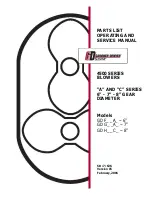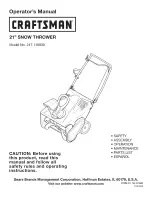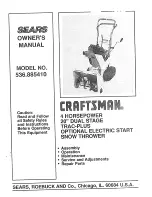
IN-ECO, spol. s r.o.
IN-ECO RING BLOWER - User manual
Version 2012.01
8
www.in-eco.eu
Differences: Depending on the model, besides the branch, the flange between the compression chamber and
the branch itself can be dismantled. Some models can also have joining (internal) threading on an indepen-
dent flange, which is then mounted to the free branch end.
Branch assembly (valid only for models supplied with dismantled branch):
Unpack the supplied branch with seals and screws, or flanges. If the flange is also dismantled, assemble it
onto the non-covered hole
〈
2
〉
first. Use the provided screws to attach the dismantled branch
〈
1
〉
to the flange
(non-covered). Apply the relevant seals during assembly. Do not remove the branch
〈
3
〉
supplied by the ma-
nufacturer. Do not remove any potential cover caps
〈
4
〉
. Other connections are not permitted.
If you are un-
certain about anything, contact the authorized IN-ECO service center.
Branches have plastic covers to prevent foreign objects from penetrating the blower. Remove covers directly
before connecting the pipe or hose. Keep them for future use, for example, during maintenance. Branches
have an internal thread, the dimensions of which are available at
www.in-eco.eu
.
4.3 I
NSTALLATION
Mechanical
Install the equipment on a solid foundation or solid base. The equipment can be installed either horizontally or
vertically (according to the orientation of the base). Use binding material with sufficient solidity to anchor the
equipment to the base and secure to avoid spontaneous loosening. The lifting loop can be dismantled after
installation.
Electrical
Only a qualified electrician can work on the electrical equipment and all relevant standards must be observed
while doing so.Connect the INW blower/pump to a power supply according to the specifications stated in the
catalog sheets also available on the www.in-eco.eu website. The equipment is supplied without connecting
electric wires. Use electrical wires of the proper strength (section) according to the electrical specifications for
the specific blower/pump stated in the catalog sheets on the www.in-eco.eu website. The wiring diagram is on
the cover of the terminal box. First, connect the grounding wire correctly. Make sure to protect against short
circuits and equipment overloading. Install a protective motor switch (motor circuit-breaker) to protect the mo-
tor against overloading. Set the switch to the nominal current stated on the equipment label. We recommend
using motor circuit-breakers, which switch the motor off with a certain time delay, with respect to potential
short-term excess current. Current greater than the nominal current can flow through the equipment for a
short period du-ring a cold start.
Check the wiring connection before permanently connecting the equipment.
Start the equipment for a short period and compare the direction of rotation with the direction indicated on the
motor ventilator cover. If necessary, change the wiring connection until the direction of the rotor rotation is the
same as the direction shown by the arrow on the motor ventilator cover. You can see the actual direction of
rotation when stopping the equipment and viewing the motor ventilator through the screen on the cover.
Pipes
The connection pipes should be 1.5 times the dimension of the equipment branch.
The
system pressure resistance (pressure losses) is increased for pipes that are excessively
narrow or long. This increases the demands on the gas (air) source and also increases
power consumption.
Choose a material for the pipe that can withstand a gas tempera-
ture that can be achieved during operation (compression). In some cases, the difference
in gas (air) temperatures can exceed 100°C (section 3.3. Temperature of discharge gases).
Fig. 3: Pipes






























